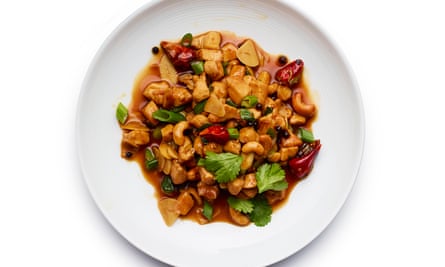Lots of shallots: why do spring onions come in such big bunches – and how can I use them all? | Australian food and drink
Buying a bunch of spring onions (sometimes known as shallots – more on that later) can often feel like a race against time. The bunches are big, yet recipes sometimes only call for a sprig or two.
If you’ve ever wondered why spring onions come in such large bundles, the answer has to do with two things: the ideal size of a spring onion and the size of an adult’s hand.
A thin spring onion is a young specimen and it is sweet and fragrant with very little spice. In contrast, thick spring onion is older with little fragrance, but it is very spicy.
According to Thanh Truong, a Melbourne fruiterer also known online as Fruit Nerd, growers have worked out that the onions hit the Goldilocks point – sweet, fragrant, spicy – when they’re 8mm in diameter. “Too small and it’s like a chive, and too big and it’s halfway to being a leek,” says Truong.

To reach this ideal diameter spring onions are planted so there’s just enough room between them to grow to 8mm.
But what about the bountiful bunches? Spring onions are harvested by hand, and the bunch you see at the markets and on supermarket shelves is the result of one hand’s worth of spring onions being pulled from the earth and bound with a rubber band.
Know your onion! Spring onions v shallots
Depending on where you live in Australia, tall green alliums are known by different names.
True spring onions (Allium fistulosum) are harvested with about 40cm of green leaves and a slightly enlarged bulb but, according to Onions Australia, these are often marketed as “shallots” in New South Wales, while Victorians and Tasmanians call them by their real name.
“True” shallots (Allium cepa, aggregatum) on the other hand, are grown for their bulbs only and are also known as eschallots.
Truong has long wondered why this is the case. His only theory is decades ago the seeds were sold to growers in each location and that’s just how they were labeled.
No matter what you call them, the way to get the most out of these hand-harvested bunches doesn’t change.
Step one: store them correctly
To maximize the shelf life of spring onions, Alex Elliott-Howery, co-author of the Food-Saver’s A-Z, recommends wrapping them in a clean tea towel and placing them in an airtight container, calico bag, or reusable plastic bag before they go in the fridge.
“If in a few days, you see one that’s starting to get a bit slimy, remove it,” she says. “The slime will spread to the rest of the shallots.”
Step two: make more than one meal
“Don’t just buy a bunch because one recipe says to garnish with them,” Elliott-Howery says. “You kind of need to go, ‘All right. What else are we going to have that week?’” She will typically plan at least three meals that need spring onions, whether that’s steamed fish, omelets, or spring-onion pancakes.

For the chef, writer, and cooking school instructor Tony Tan, living the spring-onion life means knowing exactly what to do with each part of the vegetable.
“The tips of spring onions can look a bit ratty, and I use those to make either chicken stock or stock with pork bones,” he says. “The green parts I usually use for garnishing or stir-frying.”
Tan says spring onion, ginger, and garlic are the holy trinity of Chinese cooking. The white part of the spring onion is often used with ginger and garlic as the base to stir-fries; depending on when you add the spring onions, you’ll get a different flavor. For a smoky sweetness, Tan scorches them in the wok at the start of a stir-fry. But for more vegetal-tasting spring onions, he’ll only add them at the end.

He also uses the white part of the spring onion as a substitute for onions. This makes perfect sense, especially when you consider that in Cantonese, spring onion is 蔥 (Chong) and onion is 洋蔥 (yeung Chong), which translates to “western spring onion”.
Elliott-Howery is also a fan of using the white part of the spring onion in place of the onion. “You could put it in the spaghetti bolognese … no one’s going to know,” she says.
Step three: make spring-onion oil
Spring onion oil is an efficient and delicious way to use up a big bunch of spring onions. “It doesn’t even matter if they’re a bit wilted,” Elliott-Howery says.

In her version, chop the spring onions as finely as you can be bothered and then grate some ginger. In a frying pan, bring a considerable amount of neutral oil (such as grapeseed or sunflower) to medium heat, then add the spring onions, ginger, and a generous amount of salt. Gently fry for about five minutes, remove to a bowl or jar, and then stir through some sesame oil. It will keep for up to a week in the fridge in an airtight container – Elliott-Howery likes to serve it with steamed rice, fried egg, grilled tofu, or chicken.
Truong’s recipe is speedier: he simply pours a hot neutral oil over chopped spring onions and serves them with cơm tấm (Vietnamese broken rice) or bánh hỏi (steamed vermicelli bundles). “It’s so transformative. It turns something spicy to sweet, using only heat,” he says. “It’s a wonder of nature.”
Step four: regrow them
That bunch of spring onions might seem never-ending – so you might as well embrace spring-onion infinity and (re)grow them in your kitchen. Simply trim off the green stalks, leaving just the white parts of the onion and the roots. Then place the roots in a jar, submerge them in clean water, and watch them grow on a sunny spot on the window sill. Snip off the stalks as you need them – and make sure you change the water every couple of days to keep the slime at bay.





